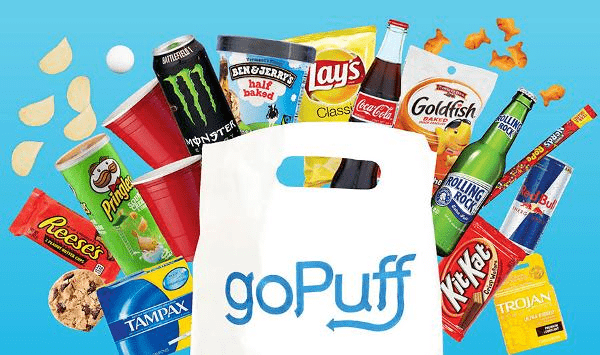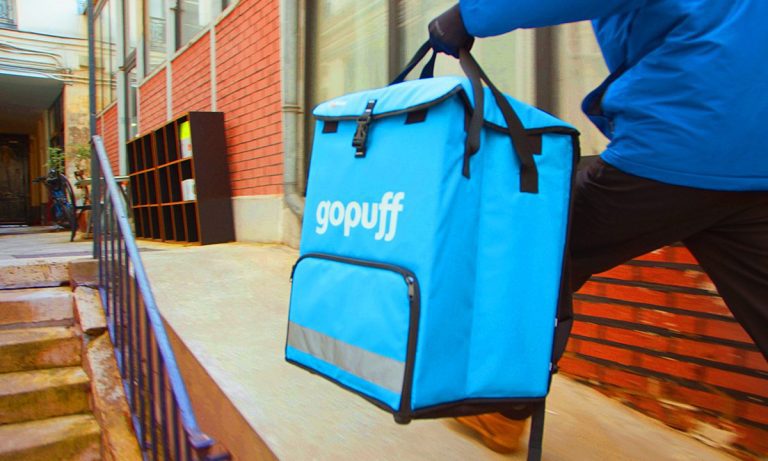What is GoPuff?
GoPuff is a consumer goods delivery business that operates on an on-demand basis. The company mostly provides snacks, drinks, and necessities that you would typically find in a convenience shop. Cleaning goods, baby products, school materials, toilet paper, over-the-counter drugs, pet food, and even a beer delivery service are all included.
Essentially, GoPuff carries all of the regular home items found at convenience stores and makes them available via an app. They have their own delivery services that fulfil orders as soon as they are placed by a consumer.
At the time of writing, GoPuff was present in over 1000 US and EU cities, with ambitions for additional national and worldwide development.

How Does GoPuff Work?
GoPuff’s business approach differs from those of other delivery firms. The firm operates its own warehouses, where it stockpiles items and fills orders on demand.
Customers may browse a wide choice of items by downloading the GoPuff app. These are the types of items you’d find in a grocery shop.
When a consumer puts an order, a GoPuff driver picks it from the nearest fulfilment centre and delivers it to the customer right away. GoPuff is accessible around the clock in several regions. In other places, the late-night delivery service is still available.
Hundreds of tiny fulfilment facilities help to service the company’s thousands of locations. The app and delivery service are transforming the convenience store sector.
How GoPuff Started
GoPuff’s journey began in 2011, when its founders, Rafael Ilishayev and Yakir Gola, met in a Business 101 class at Drexel University in Philadelphia.
Because of their similar backgrounds, the two quickly became friends and subsequently housemates. Both were immigrants’ children who had worked in their family’s company.
Ilishayev, who was born in Russia, originally worked at his father’s sandwich store and then at a banquet hall that his father had purchased. Gola, the son of an Israeli immigrant, also worked in his father’s cash-for-gold store.
Gola was fortunate to have a car in college. However, because none of his buddies had automobiles, he was forced to make late-night drives to get snacks when the cravings struck.
After another late-night run with Ilishayev tagging along, they thought there had to be a better way to get stuff from convenience stores. They figured if people are already getting take-out delivered, why couldn’t they do the same with convenience goods?
Excited by the idea, they shared it with their friends and family, but none of them thought it made sense. They all said they’d rather go to a convenience store than order from an app.
But the two decided to push on with their idea. They figured that there were tons of college students like them that would much rather get their late-night snacks delivered than make the trip to the store themselves.
They targeted the pot and tobacco smokers looking for hookahs, vaporizers, grinders, and rolling papers. They even had eye drops and a selection of snacks available, with delivery ending at 4:20 AM.
Launching GoPuff
GoPuff was launched in 2013 in Philadelphia, Pennsylvania. They first targeted university students, with the founders delivering deliveries themselves.
They quickly discovered that their concept succeeded, but the two college student founders encountered significant hurdles as they grew the startup. These included funding, software development, user acquisition, stock purchase, and delivery coordination.
To support GoPuff, the two took advantage of every opportunity. A family friend offered them what was left in their previous office building while they were hunting for furnishings. They retained what they needed and sold the remainder of the office furniture for a total of $60,000 on Craigslist.
This was enough to buy supplies, rent a warehouse, and pay the Ukrainian programmers they’d hired to create the app.
To get students to use their service, the pair persuaded instructors to allow them to promote the app to students before courses. They also distributed promotional bottle openers, lighters, and magnets.
Ilishayev and Gola had to persuade suppliers to let them buy products on credit because they didn’t have much money. This was difficult because they were a new company with no credit history. One method they employed was to overestimate the size of the consumer base.
Also Read: Snackpass – A Social Food Ordering App Making Ordering Convenient
They couldn’t even afford delivery drivers. So they ran all deliveries personally for the first six months. They were also in charge of all other parts of the company, such as orders, inventory marketing, bookkeeping, and customer support.
They worked 16-hour days, seven days a week at this time. They’d sometimes have to leave class to make a delivery.
But all of their efforts paid off. They had an outstanding 25,000 consumers and 25 drivers by 2014.
GoPuff Growth
The GoPuff founders chose to shift their focus away from stoners and students in 2014. Instead, they transformed themselves into a self-service convenience store.
They abandoned their raunchy marketing campaign as part of this adjustment. This includes pictures of half-naked ladies on their website and advertisements such as “Who’s getting LAYS tonight?” “Delivery when the bra is off but the munchies are on,” for example.
As a result, the average age of their customers increased from 18-22 to 25-34. This enabled them to serve a broader spectrum of individuals.
They extended to schools in Boston, Washington, D.C., and Austin the next year, while still seniors. This was difficult since they were bootstrapping the firm and barely had enough money for the essential necessities.
To save money, they even slept in their GoPuff warehouses instead of paying for hotel rooms. This devotion to their business was successful. Within a year, they had processed 500,000 orders in nine major cities.
Three things influence the opening of a new GoPuff store. They’ll need to rent a mini fulfilment facility, recruit drivers, and enlist the help of local suppliers. If one of these elements is missing, the entire structure collapses.
Even so, not all cities function. When they attempted to expand to New York in 2015, they were only able to do so for two years due to expensive property prices and other strong late-night choices.
Nonetheless, these three lessons have assisted GoPuff in expanding to over 1000 cities served by hundreds of micro fulfilment facilities.
How Does GoPuff Make Money?
GoPuff earns money by meeting what company refers to as “immediate needs.”
GoPuff charges a flat $2 shipping fee on orders above $49. However, the delivery cost is paid to the delivery driver.
GoPuff makes money by overcharging for its products. The platform is certainly more convenient than convenience shops, but it is also more costly. More recently, GoPuff has made money by advertising higher app placement.
GoPuff Revenue and Value
GoPuff achieved $1 billion in revenue in 2021, three times what it did in 2020, thanks in part to the epidemic.
Nonetheless, the firm is not profitable. While it claims to be successful in all markets where it has been in business for at least eighteen months, a quarter of its centres are losing money.
However, Ilishayev and Gola attribute this to their large spending to control GoPuffs’ hypergrowth. Automation, routing software, and other technologies are heavily invested in to assist pack and transport goods more effectively. They claim that if they didn’t invest in expansion, they’d be profitable straight away.
However, GoPuff is not the only delivery business that is losing money. UberEats, DoorDash, and Grubhub are also losing money, and none of them have the additional overhead of having smaller fulfilment centres.
Also Read: DoorDash – The Great Food Delivery App And Beyond
Acquisitions account for another portion of GoPuff’s expenses. GoPuff has booze stores, delivery services, and a software firm to aid in its international development.
GoPuff financed all of this spending with $3.4 billion raised in nine rounds, with its most recent $1 billion investment round in July 2021 valued at a whopping $15 billion.
What’s Next for GoPuff?
Going forward, GoPuff intends to expand throughout the United Kingdom and Europe.
According to sources, GoPuff is in discussions to purchase Berlin-based delivery business Flink in order to compete with Gorillas, the largest German delivery service. Getir from Turkey is another significant European company it’ll have to compete with, as are smaller players like Weezy, Jiffy, and Deliveroo.
GoPuff is also expanding its product range with healthy snacks, cosmetic and baby categories, and Curated Mystery Boxes.
Finally, GoPuff intends to open a location in San Francisco. Customers will place their orders through computerised terminals. Workers then retrieve the items from a product storage room that also processes online purchases and deliver them to the consumer.
To read more content like this, subscribe to our newsletter
[wpforms id=”320″]
